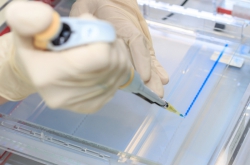How DNA-based pharmaceuticals are made.
Protein is one of the basic organic compounds in all living creatures’ organisms. And it’s important not just for gaining muscle mass at the gym, but for other things, too. Some proteins control the organism’s metabolism and transport various microelements and molecules – for instance, hemoglobin delivers oxygen to the cells. Proteins also serve a defensive role by neutralizing toxins, take part in blood coagulation and other vital processes. When the organism is ill or traumatized, a person’s own resources are often insufficient for dealing with the pathological processes. There’s a reason some people catch colds in winter and others don’t. Often illnesses and ailments appear when the body is exhausted for some reason. The technology that “ATG Service Gene” is working on is based on injecting human cells with genes that then encode certain proteins for this or that therapeutic purpose. This results in the organism receiving resources that it otherwise would have lacked to cure itself properly.
Gene-therapeutic pain relievers
The company has developed the world’s first gene-therapeutic painkiller that is currently being patented internationally. They have already been granted patents in Russia, USA, Japan and Brazil. Patents in other countries are currently pending. The majority of pain relievers sold at pharmacies right now work only for several hours.

Ilya Dukhovlinov
“The human organism contains proteins responsible for blocking pain – for example, certain types of endorphins. When the organism is weakened, it can’t produce such proteins in a sufficient amount. But if we inject endorphin-replicating DNA into the system, its production increases and the person no longer feels pain. This way we’re also avoiding the injection of any chemicals into the body, especially morphine- or opioid-based ones” – explained “ATG Service Gene” founder Ilya Dukhovlinov.
The painkiller’s effect, just like with all of the company’s gene-therapeutic drugs, lasts for seven days. This amount wasn’t chosen arbitrarily. Firstly, it’s long enough to make the patient’s treatment more comfortable and not to make them take ten pills every day. Secondly, it’s safer than producing a longer-lasting drug in case the treatment causes an unnecessary reaction or needs to be stopped – in which case instead of having to block the drug, you just need to not give the next dose to the patient.
DNA is injected into the organism through a simple intramuscular injection. Endorphins are usually only produced by the central nervous system. But when endorphin-encoding DNA is injected into muscular tissue, the muscle cells at the injection spot transform themselves and begin to produce endorphin. A new source of endorphins is formed and, importantly, is active for only a week.

Tissue regeneration
DNA encoding can also be used to enhance regeneration of tissue. Some types of trauma, such as hip and sternum fractures, tendon raptures, etc., can’t be healed by just bandaging and casts. They often require surgery and temporary or permanent implants. These injuries could be treated using DNA that would encode “building” proteins.
A more effective way to boost regeneration is not through injection, but using electroporation technology. This is because an injected drug will sooner or later disperse through the organism, making its efficiency lower in the region of injury. Using electroporation allows for more targeted delivery of DNA to the cell. DNA is placed next to the cell and then targeted with a short high-voltage electrical impulse. This causes a “puncture” in cell membrane that “sucks in” the DNA chain due to pressure difference. This method only works for applying DNA to damaged tissue that requires a certain protein type.
“It is also acceptable and effective for in-patient treatment when lengthy procedures are an option. Of course, the growth factors in the whole organism will be slightly affected after such procedures – it is a systemic action, after all – but the effect outside the area of application will be minimal. We can also control the local-systematic aspect by including additional genetic elements into the injected DNA chain” – says Ilya Dukhovlinov.

Extending lab mice’s life cycle and prolonging wakefulness.
According to Mr. Dukhovlinov, all modern methods of treatment of aging and age-related illnesses are based on the introduction of stimulating factors into the organism: hormones, vitamins, etc. But despite increasing the amount of such substances in the organism, these methods are not very effective. Why? Because with age the cells’ surfaces lose some of the receptors they use to acquire essential materials. Right now, there are mice aged 3,8 years living at “ATF Service Gene”. Yet they are spry and youthful-looking. Their contemporaries living next to them are decrepit and barely active. Why is that? The reason is that the former were injected with DNA that encodes receptor proteins, including sexual hormone receptors.
“This technology could be used with other types of receptors, too – insulin, for instance. Why do people gain weight with age? The reason for that is that there are less insulin receptors, yet more insulin is produced. So, in theory, we could heal even type II diabetes by growing insulin receptors on the surface of human cells” – explained the founder of “ATG Service Gene”.

DNA injections could also be used to synthesize increased amounts of various peptides that are produced during sleep. This would serve to prolong periods of wakefulness in people. If one doesn’t sleep, the amount of certain protein drops, which sends a signal to the brain that the organism needs rest. Such technology could be useful for military purposes.
Treating cancer and infection through gene silencing
A process known as RNA interference is used to suppress gene expression, meaning that one type of RNA suppresses a different one. As a result, a particular gene is not transformed into its final product – a protein or RNA (RNA is a protein encoder that is produced according to code extracted from DNA or other RNA – quite a complicated cycle). A cell can be injected with DNA that would produce RNA that can block certain “harmful” genes. These could be genes responsible for, say, the creation of cancer cells. This method can also stop infectious diseases such as hepatitis C by simply stopping virus cells from replicating themselves.

“Of course, when we work with cancerous tumors, it’s important to keep an eye on the healthy cells. For that reason, during our experiments, we track expression levels of all the important genes; we’ve calculated the necessary amount of DNA per cell for a mammal of a certain size and weight. With a few changes, this method can be used with humans – human and mouse DNA are similar, but not quite the same. Because of that we need to conduct very careful clinical testing of our finished product. I believe that DNA-based pharmaceuticals are the future, as it is always better to allow the organism to protect itself instead of swarming it with chemicals” – concludes Ilya Dukhovlinov.





